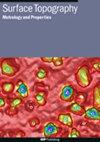二氧化硅/PDMS复合涂层制备自洁超疏水棉织物
IF 2
3区 材料科学
Q2 ENGINEERING, MECHANICAL
引用次数: 0
摘要
摘要:荷花效应表明,可以通过产生粗糙的表面结构并用具有低表面能的化学物质修饰它们来获得自清洁超疏水表面。通过多次浸渍,将疏水二氧化硅纳米颗粒(SNPs)与聚二甲基硅氧烷(PDMS)复合沉积在棉织物上。在最佳条件下,聚类snp在PDMS中形成分层粗糙表面,涂层棉织物的水接触角(WCA)为158.41±1.58°,滑动角为4°。由于超疏水表面的水附着力可以忽略,涂层棉织物表现出优异的自清洁性能,通过灰尘颗粒,泥水和茶滴进行了测试。此外,涂层棉织物在胶带剥离试验、砂纸磨损试验和超声波等机械稳健性试验中仍保持超疏水性。因此,这种方法可能适用于纺织工业的自清洁目的。本文章由计算机程序翻译,如有差异,请以英文原文为准。
Development of Self-cleaning Superhydrophobic Cotton Fabric through Silica/PDMS Composite Coating
Abstract The lotus effect informs that self-cleaning superhydrophobic surfaces can be obtained by creating rough surface structures and modifying them with chemicals that have low surface energy. Herein, the composite of hydrophobic silica nanoparticles (SNPs) and polydimethylsiloxane (PDMS) was deposited on cotton fabric by multiple dip cycles. At optimal condition, the agglomerated SNPs in PDMS produces a hierarchical rough surface, as a result the coated cotton fabric has revealed a water contact angle (WCA) of 158.41 ± 1.58° and 4° of sliding angle. Due to negligible water adhesion to a superhydrophobic surface, coated cotton fabric reveals excellent self-cleaning behavior, which was tested by dust particles, muddy water and tea droplets. Furthermore, coated cotton fabric sustains superhydrophobicity over the mechanical robustness tests including adhesive tape peeling test, sandpaper abrasion test, and ultrasonication. Therefore, such an approach may be applicable in textile industries for self-cleaning purposes.
求助全文
通过发布文献求助,成功后即可免费获取论文全文。
去求助
来源期刊

Surface Topography: Metrology and Properties
Materials Science-Materials Chemistry
CiteScore
4.10
自引率
22.20%
发文量
183
期刊介绍:
An international forum for academics, industrialists and engineers to publish the latest research in surface topography measurement and characterisation, instrumentation development and the properties of surfaces.
 求助内容:
求助内容: 应助结果提醒方式:
应助结果提醒方式:


